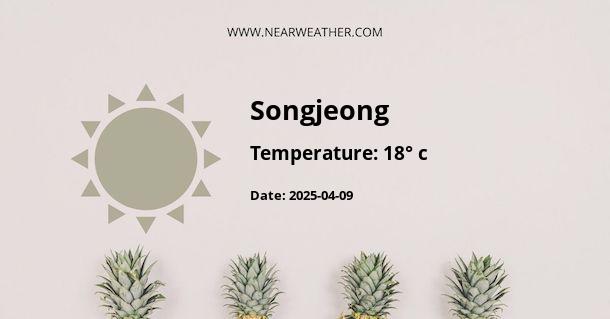Climate and Weather in Songjŏng, South Korea
Songjŏng, a district located in the city of Kimhae in South Korea, experiences a temperate climate with distinct seasons throughout the year. The region is influenced by the East Asian monsoon, which brings in warm, humid summers and cool, dry winters. Let's explore the climate and weather patterns in Songjŏng in more detail.
Temperature
The average annual temperature in Songjŏng is around 13.5°C (56.3°F). Summers are generally hot and humid, with temperatures ranging from 25°C to 30°C (77°F to 86°F) in July and August. Winters, on the other hand, can be quite cold, with temperatures dropping to around 0°C (32°F) in December and January. Spring and autumn are mild and pleasant, with temperatures ranging from 10°C to 20°C (50°F to 68°F).
Here is a table summarizing the average monthly temperatures in Songjŏng:
| Month | Average Temperature (°C) |
|---|---|
| January | 0.2 |
| February | 2.6 |
| March | 7.2 |
| April | 13.1 |
| May | 17.7 |
| June | 21.9 |
| July | 24.9 |
| August | 25.4 |
| September | 21.2 |
| October | 15.3 |
| November | 8.2 |
| December | 2.1 |
Precipitation
Songjŏng receives a moderate amount of rainfall throughout the year, with the wettest months being July and August. The district experiences a monsoon season during the summer months, characterized by heavy rainfall and occasional thunderstorms. The average annual precipitation in Songjŏng is approximately 1,300 mm (51 inches).
Here is a chart showing the average monthly precipitation in Songjŏng:
Sunshine Hours
Songjŏng enjoys a good amount of sunshine throughout the year, with the sunniest months being May, June, and July. The district experiences an average of around 2,200 to 2,400 hours of sunshine annually. However, during the monsoon season, the sunshine hours tend to decrease due to cloud cover and rainfall.
Wind
Songjŏng experiences moderate to strong winds throughout the year, influenced by various weather systems such as high-pressure systems, low-pressure systems, and the monsoon. The prevailing wind direction in the region is from the northwest during the winter months and from the southwest during the summer months. Wind speeds can reach up to 20 to 30 km/h (12 to 18 mph) during certain periods.
Typhoons
Songjŏng is occasionally affected by typhoons, which are tropical cyclones that form in the western Pacific Ocean. The typhoon season typically occurs from July to September, with August being the peak month. These powerful storms can bring strong winds, heavy rainfall, and storm surges to the region.
Conclusion
Songjŏng experiences a temperate climate with distinct seasons. Summers are hot and humid, winters are cool and dry, and spring and autumn are mild and pleasant. The district receives a moderate amount of rainfall throughout the year, with the wettest months being July and August. Songjŏng enjoys a good amount of sunshine annually, but the sunshine hours can be reduced during the monsoon season. Moderate to strong winds and occasional typhoons also influence the weather in this region. Understanding the climate and weather patterns in Songjŏng is important for residents and visitors alike to plan their activities and be prepared for any weather-related events.
A - Songjeong's Latitude is 35.589169 & Longitude is 129.357224.
A - Weather in Songjeong is 19° today.
A - Climate Conditions in Songjeong shows clear sky today.
A - Humidity in Songjeong is 45% today.
A - Wind speed in Songjeong is 8.06 km/h, flowing at 200° wind direction. today.
